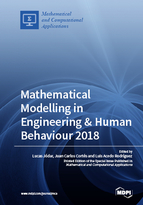Mathematical Modelling in Engineering & Human Behaviour 2018
A special issue of Mathematical and Computational Applications (ISSN 2297-8747).
Deadline for manuscript submissions: closed (30 November 2018) | Viewed by 44518
Special Issue Editors
Interests: computational methods in finances; boundary value problems; random differential equations
Special Issues, Collections and Topics in MDPI journals
Interests: random differential equations
Special Issues, Collections and Topics in MDPI journals
Interests: gravitation; modified theories of gravity; neural networks; mathematical epidemiology
Special Issues, Collections and Topics in MDPI journals
Special Issue Information
Dear Colleagues,
Please visit this site http://jornadas.imm.upv.es/jornadas/ for a detailed description of this Special Issue. The Special Issue will mainly consist of selected papers presented at the "Mathematical Modelling in Engineering & Human Behaviour 2018". Papers considered to fit the scope of the journal and of sufficient quality, after evaluation by the reviewers, will be published free of charge. The main topics of this Special Issue are:
- Financial Mathematics
- Networks and Applications
- Mathematical Models in Medicine
- Internal Combustion Engines
- Mathematical Models in Engineering and Numerical Simulation
- Social Addictions and Public Health
Prof. Dr. Lucas Jódar
Prof. Dr. Juan Carlos Cortés
Prof. Dr. Luis Acedo
Guest Editors
Manuscript Submission Information
Manuscripts should be submitted online at www.mdpi.com by registering and logging in to this website. Once you are registered, click here to go to the submission form. Manuscripts can be submitted until the deadline. All submissions that pass pre-check are peer-reviewed. Accepted papers will be published continuously in the journal (as soon as accepted) and will be listed together on the special issue website. Research articles, review articles as well as short communications are invited. For planned papers, a title and short abstract (about 100 words) can be sent to the Editorial Office for announcement on this website.
Submitted manuscripts should not have been published previously, nor be under consideration for publication elsewhere (except conference proceedings papers). All manuscripts are thoroughly refereed through a single-blind peer-review process. A guide for authors and other relevant information for submission of manuscripts is available on the Instructions for Authors page. Mathematical and Computational Applications is an international peer-reviewed open access semimonthly journal published by MDPI.
Please visit the Instructions for Authors page before submitting a manuscript. The Article Processing Charge (APC) for publication in this open access journal is 1400 CHF (Swiss Francs). Submitted papers should be well formatted and use good English. Authors may use MDPI's English editing service prior to publication or during author revisions.








